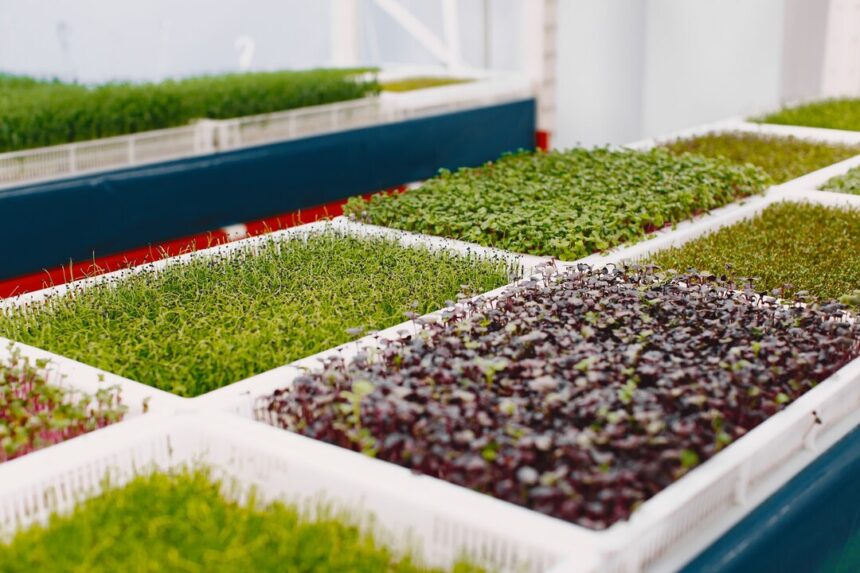Microgreens farming has gained immense popularity among growers and consumers alike, offering a lucrative opportunity to cultivate nutrient-dense greens in a compact space with rapid turnaround times. These miniature plants, packed with flavor and nutrition, are not only delicious additions to culinary creations but also contribute to a sustainable and profitable agricultural venture. Whether you’re a seasoned farmer or a novice entrepreneur, here are essential tips to ensure success in microgreens farming:
1. Select Suitable Varieties:
- Choose microgreen varieties that thrive in your local climate and growing conditions. Popular options include broccoli, radish, kale, arugula, sunflower, pea shoots, and basil. Experiment with different flavors, colors, and textures to appeal to diverse consumer preferences.
2. Source High-Quality Seeds:
- Invest in high-quality, organic seeds specifically intended for microgreens production. Ensure the seeds are untreated and free from contaminants to promote healthy germination and vigorous growth.
3. Optimal Growing Environment:
- Create an optimal growing environment for microgreens by providing adequate light, temperature, humidity, and ventilation. Consider setting up a dedicated indoor growing area equipped with grow lights, climate control systems, and shelving units for efficient space utilization.
4. Quality Growing Medium:
- Use a sterile, well-draining growing medium suitable for microgreens cultivation. Common options include soilless mixes, coconut coir, vermiculite, or hydroponic mats. Ensure the medium is free from pathogens and provides adequate support for seedling development.
5. Proper Sowing Techniques:
- Sow microgreen seeds densely and evenly over the growing medium to maximize yield and minimize competition among seedlings. Press the seeds gently into the surface of the medium to ensure good soil contact for germination.
6. Consistent Watering Schedule:
- Maintain consistent moisture levels throughout the growing process by watering the microgreens regularly. Use a misting spray bottle or a gentle watering can to avoid disturbing the delicate seedlings and prevent soil compaction.
7. Adequate Light Exposure:
- Provide microgreens with ample light exposure to promote healthy growth and development. Position grow lights approximately 4-6 inches above the seedlings and adjust the light intensity and duration based on the specific requirements of each variety.
8. Monitor Growth Progress:
- Monitor the growth progress of microgreens closely to identify any issues or deficiencies early on. Keep track of germination rates, growth rates, and overall plant health to make timely adjustments to watering, lighting, or nutrient levels as needed.
9. Harvesting at the Right Time:
- Harvest microgreens at the optimal stage of growth, typically when they reach 1-3 inches in height and develop their first true leaves. Use clean scissors or a sharp knife to cut the seedlings just above the soil line for maximum freshness and flavor.
10. Post-Harvest Handling:
- Handle harvested microgreens with care to preserve their quality and shelf life. Rinse the seedlings under cold water to remove any soil or debris, then gently pat them dry with paper towels before packaging or storage.
11. Packaging and Presentation:
- Package microgreens attractively in clean, food-safe containers or clamshells to enhance their marketability and appeal to consumers. Label the packaging with the variety name, harvest date, and any relevant nutritional information for transparency and consumer confidence.
12. Storage and Shelf Life:
- Store harvested microgreens in airtight containers or bags lined with paper towels in the refrigerator to maintain freshness and extend shelf life. Keep the temperature and humidity levels consistent to prevent wilting or spoilage.
13. Marketing and Distribution:
- Develop a marketing strategy to promote your microgreens and reach your target audience effectively. Utilize social media, farmers’ markets, community-supported agriculture (CSA) programs, and local restaurants or grocery stores to market and distribute your products.
14. Continuous Crop Planning:
- Plan for continuous production by staggering sowings and harvests to ensure a steady supply of fresh microgreens year-round. Keep detailed records of planting dates, harvest yields, and customer feedback to optimize your production schedule and meet market demand.
15. Pest and Disease Management:
- Implement integrated pest management (IPM) practices to prevent and manage pest infestations and disease outbreaks in your microgreens crop. Monitor for signs of pests or diseases regularly and use biological controls, cultural practices, or organic pesticides as needed.
16. Scaling Up Production:
- Consider scaling up your microgreens operation gradually to meet increasing demand and expand your market reach. Invest in additional equipment, infrastructure, and labor as necessary to support larger production volumes while maintaining quality and consistency.
17. Continuous Learning and Improvement:
- Stay informed about the latest developments and innovations in microgreens farming through industry publications, workshops, and networking opportunities. Experiment with new varieties, growing techniques, and marketing strategies to stay competitive and adapt to changing market trends.
By implementing these tips and best practices, you can cultivate high-quality microgreens efficiently and profitably while contributing to a more sustainable and resilient food system. Whether you’re growing microgreens for personal enjoyment or commercial purposes, the satisfaction of harvesting fresh, nutritious greens from your own garden is truly rewarding.
Join 'Farmers Mag' WhatsApp Channel
Get the latest Farming news and tips delivered straight to your WhatsApp
CLICK HERE TO JOIN






